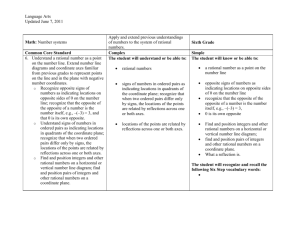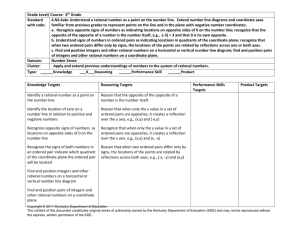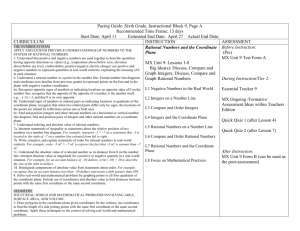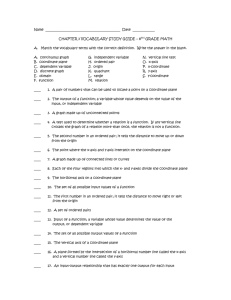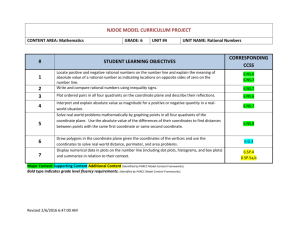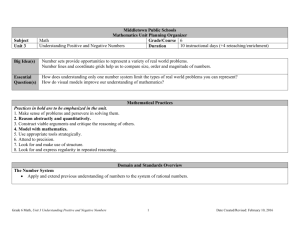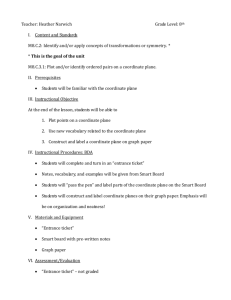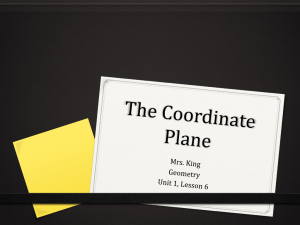6 – Rational Numbers and the Coordinate Plane Unit Number: 9
advertisement
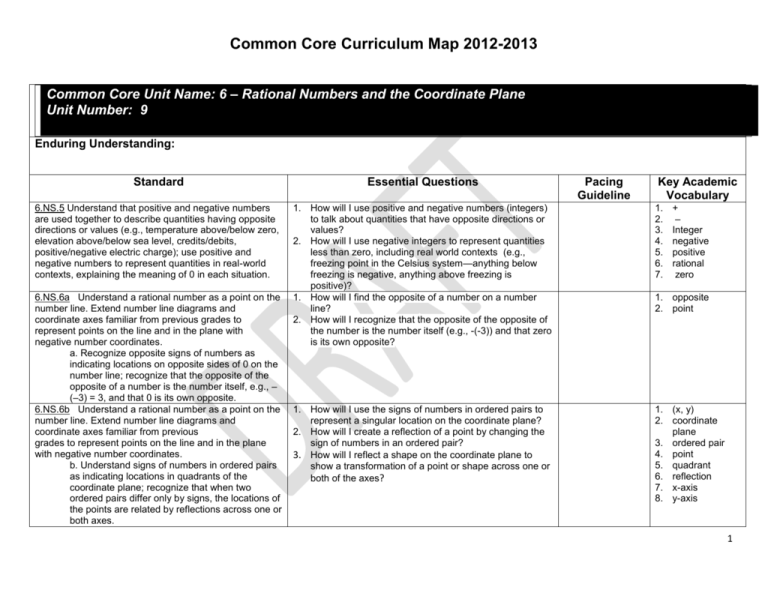
Common Core Curriculum Map 2012-2013 Common Core Unit Name: 6 – Rational Numbers and the Coordinate Plane Unit Number: 9 Enduring Understanding: Standard Essential Questions 6.NS.5 Understand that positive and negative numbers are used together to describe quantities having opposite directions or values (e.g., temperature above/below zero, elevation above/below sea level, credits/debits, positive/negative electric charge); use positive and negative numbers to represent quantities in real-world contexts, explaining the meaning of 0 in each situation. 1. How will I use positive and negative numbers (integers) to talk about quantities that have opposite directions or values? 2. How will I use negative integers to represent quantities less than zero, including real world contexts (e.g., freezing point in the Celsius system—anything below freezing is negative, anything above freezing is positive)? 1. How will I find the opposite of a number on a number line? 2. How will I recognize that the opposite of the opposite of the number is the number itself (e.g., -(-3)) and that zero is its own opposite? 1. 2. 3. 4. 5. 6. 7. 1. How will I use the signs of numbers in ordered pairs to represent a singular location on the coordinate plane? 2. How will I create a reflection of a point by changing the sign of numbers in an ordered pair? 3. How will I reflect a shape on the coordinate plane to show a transformation of a point or shape across one or both of the axes? 1. (x, y) 2. coordinate plane 3. ordered pair 4. point 5. quadrant 6. reflection 7. x-axis 8. y-axis 6.NS.6a Understand a rational number as a point on the number line. Extend number line diagrams and coordinate axes familiar from previous grades to represent points on the line and in the plane with negative number coordinates. a. Recognize opposite signs of numbers as indicating locations on opposite sides of 0 on the number line; recognize that the opposite of the opposite of a number is the number itself, e.g., – (–3) = 3, and that 0 is its own opposite. 6.NS.6b Understand a rational number as a point on the number line. Extend number line diagrams and coordinate axes familiar from previous grades to represent points on the line and in the plane with negative number coordinates. b. Understand signs of numbers in ordered pairs as indicating locations in quadrants of the coordinate plane; recognize that when two ordered pairs differ only by signs, the locations of the points are related by reflections across one or both axes. Pacing Guideline Key Academic Vocabulary + – Integer negative positive rational zero 1. opposite 2. point 1 Common Core Curriculum Map 2012-2013 6.NS.6c Understand a rational number as a point on the number line. Extend number line diagrams and coordinate axes familiar from previous grades to represent points on the line and in the plane with negative number coordinates c. Find and position integers and other rational numbers on a horizontal or vertical number line diagram; find and position pairs of integers and other rational numbers on a coordinate plane 6.NS.7a Understand ordering and absolute value of rational numbers. a. Interpret statements of inequality as statements about the relative position of two numbers on a number line diagram 1. How will I use an observation is (e.g. sample size, n size) and how it relates to numerical data sets? 2. How will I explain why the number of observations is important to summarizing numerical data sets? 6.NS.7b Understand ordering and absolute value of rational numbers. b. Write, interpret, and explain statements of order for rational numbers in real-world contexts. 1. How will I determine how data was collect and justify the appropriateness of the process used for data collection? 2. How will I determine the importance of the units used in the data sets? 1. 1st Quartile (Q1) 2. 2nd Quartile (Q2) 3. 3rd Quartile (Q3) 4. 4th Quartile (Q4) 5. Box plot (boxand-whisker) 6. distribution 7. dot plot (line plot) 8. histogram 9. Interquartile range 10. upper quartile, lower quartile median 11. upper 12. endpoint (upper extreme) 13. lower endpoint (lower extreme) 1. data set 2. observation 3. sample size 1. abbreviations for common measurements 2. attribute 3. characteristic 4. investigation 2 Common Core Curriculum Map 2012-2013 6.NS.7c Understand ordering and absolute value of rational numbers. c. Understand the absolute value of a rational number as its distance from 0 on the number line; interpret absolute value as magnitude for a positive or negative quantity in a real-world situation. 6.NS.7d Understand ordering and absolute value of rational numbers. d. Distinguish comparisons of absolute value from statements about order 1. How will I use absolute value to describe a number’s distance from zero on a number line? 2. How will I determine that absolute value in a real-world context refers to the positive value of a number? 3. How will I determine when quantities may have a negative value based on context (e.g., below, debt, behind, etc.)? 1. How will I model that as the value on a negative rational number decreases, its absolute value increases? 2. How will I order rational numbers based on their magnitude? 1. lxl 2. l−xl 3. absolute value 6.NS.8 Solve real-world and mathematical problems by graphing points in all four quadrants of the coordinate plane. Include use of coordinates and absolute value to find distances between points with the same first coordinate or the same second coordinate. 1. How will I determine the distance from a line segment from one coordinate pair to another? 2. How will I determine if two coordinates lie on the same line by the x and y value of the coordinates? 3. How will I use the absolute value to determine the distance from a point on a coordinate plane? 4. How will I use the coordinate plane to represent real world contexts (e.g. streets)? 1. coordinate plane 2. coordinate 3. point Suggested Resources by Unit 1. value 2. decrease 3. ncrease Location of these resources 3 Common Core Curriculum Map 2012-2013 4
